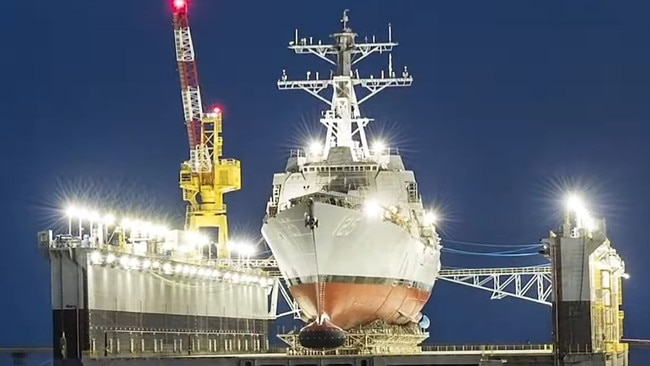Rethink needed for frigate program
Australia cannot afford to operate large ships optimised for a single role. In cost and capability terms, having ships that excel in the widest possible range of defensive and offensive missions makes the most sense.

In 2009, Australia decided that it would replace eight Anzac frigates with nine ships optimised for anti-submarine warfare (ASW). There was no such justification in the Royal Australian Navy’s (RAN) capstone doctrine for acquiring and optimising a frigate for ASW, which it regarded as among the most difficult of naval operations to be conducted, and most effectively performed using submarines and aircraft of various kinds.
Powerful and survivable large surface combatants remain essential components in the RAN’s order of battle. But they must be fit for purpose. Australia cannot afford to operate large ships optimised for a single role. In cost and capability terms, having ships that excel in the widest possible range of defensive and offensive missions makes the most sense. This includes ASW, air defence, anti-shipping and land attack, and command and control at sea. Being a controlling node for unmanned vehicles of various types is coming.
Three contenders were assessed for the frigate program. The Italian FREMM was already in service. Spain’s Navantia offered a derivative of the Hobart Class, known as the F-5000, proposing an extended flight deck, two hangars and an integrated mast to carry the CEA Radar. The third design, the British Type 26 was incomplete, but the first ship had commenced construction. Navantia offered the lowest technical risk, but the others would need considerable modification for equipping with the RAN’s sensibly mandated changes. These included the USN’s Aegis combat system – itself to be integrated with a new Australian-developed, advanced phased array radar, the US Standard missile system, Australian specified communications systems, and USN helicopters.
In 2018, the Type 26 was selected as the basis for the Hunter frigate, which will be a derivative of the British design. BAE Systems (UK) had never integrated a US combat system into its ship designs, and incorporation of the Australian radar into Aegis had yet to be demonstrated. Defence described aspects of the risk as extreme.

With an estimated displacement of 10,000 tonnes, it will become the RAN’s most numerous and largest, but least well-armed surface combatant. Not including deck-mounted launchers, it will have 32 missile cells, being 16 fewer than the 7000 tonne Hobart class with 48, and 64 less than the USN DDG-51 being about 9700 tonnes, with 96. The Hunter will operate a single helicopter with space to carry a second, versus two for the DDG-51. China’s Type 055 destroyer is about 12,000 tonnes, has 136 cells and two helicopters.
Using the total estimated (but contestable) program costs, the approximate cost of a missile cell in the nine ship Hunter class will be $130m vs $31m per cell for 10 ships of the DDG-51 Flight III. The Hunter’s expected crew of 180 contrasts with 329 for a DDG-51. Nonetheless, it will take three Hunters to deliver the same fire power as a single DDG-51 and require 211 extra crew.
In 2013, the government expected that its future surface combatant would provide an option to conduct strategic strike if it chose to acquire that capability.
In 2021, Australia announced acquisition of Tomahawk for land attack. It can be fitted to both the Hobart and Hunter classes. The Hunter’s combat system will also be capable of ballistic missile defence using the SM-3 missile if the government so decided, and for which it has expressed a desire to remain present.
With only 32 cells, operational choices will have to be made as to how many ESSM, SM-2 or SM-6, Tomahawk or potentially SM-3 missiles the Hunter frigate carries. High expenditure will require ammunition resupply, a task not possible while underway. A ship off-station is no use to those on active operations.
A misguided optimisation for ASW operations has resulted in Australia choosing the wrong ship. Unpalatable as it will be, we should stop and redirect the Hunter frigate program. Agreement should be reached with the US government to construct in Australia nine ships of the USN DDG-51 Flight III destroyer, integrating the Australian phased array radar.
If negotiations with the US are not expeditious, a further three to four ships of the Hobart class already in service with the RAN should commence construction as soon as possible, utilising as much as possible of the combat systems and other equipment already being procured for the Hunter class.
A longer-term program of collaboration with the United States should be commenced to join its new large surface combatant program (DDG X), integrating the Australian radar, and timing Australia’s entry as the end of life of the first of the Hobart class is being approached.
Australia’s naval shipbuilding industry should be provided with multi-decade planning information necessary for its proper preparation to deliver the required ships and submarines to the RAN. The industry should plan for and then build those ships in remediation of the Hunter program.
RAN’s future ship and submarine programs should be mandated to be built by Australian-owned prime contractors, utilising overseas designers and systems as needed, and to incorporate an Australian industrial content judged necessary to sustain that industry by an arrangement involving the RAN and industry, and approved by government.
Long-term planning, in the order of 30 years, should be implemented by the RAN wherein it provides a clear and publicly available articulation of when its large and small combatants, and submarines, will reach the ends of their lives. This will include announcing when replacements will be sought in a timely manner in advance of their retirement. The public will similarly be given lengthy notice of intended changes to the composition of the RAN’s fleet.
These plans should be approved annually by government.
The arrangements for overall management of Australia’s sovereign shipbuilding program should be adjusted to ensure maximum control by the government over the choice of its naval platforms and fostering of its associated supply chains.
-
Vice Admiral David Shackleton served as Chief of Navy from 1999-2002. He is the author of The Hunter frigate: an assessment published by Australian Strategic Policy Institute last month.


